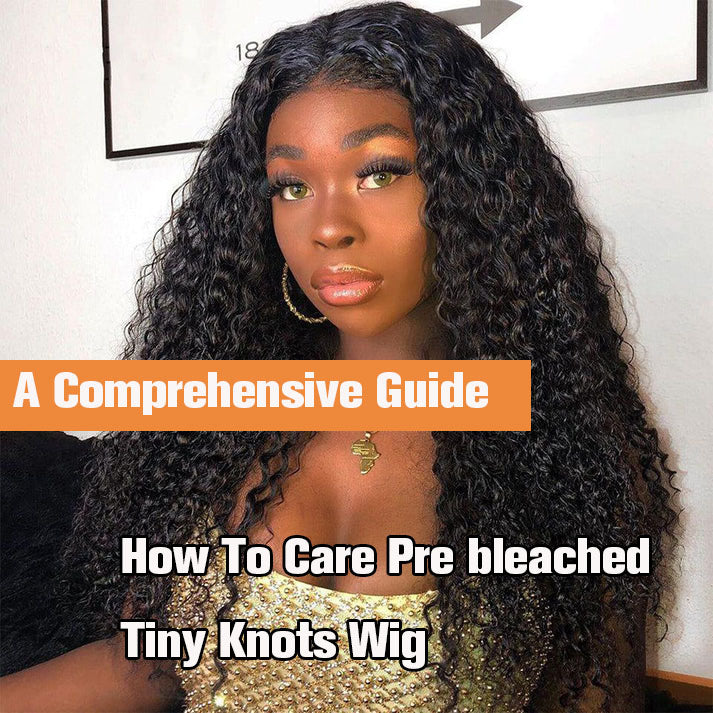
A Comprehensive Guide of How To Care Pre bleached Tiny Knots Wig
Pre bleached tiny knots wigs. meticulously crafted to mimic the appearance of natural hair, providing the most seamless and realistic look in the wig market.
So in this comprehensive guide, we'll explore mantenance of tiny knots wig, ensure that your investment in a tiny knots wig is well-maintained and enjoyed for years to come.
Why Should We Bleach Knots on Our Lace Front Wigs?

Bleaching knots on lace front wigs is essential to create a natural appearance by making the knots, which secure each hair strand to the wig's lace, less visible. This technique enhances the wig's realism, helps achieve an undetectable hairline, and boosts confidence by making the wig look like natural hair growing from the scalp.
Unbleached Knots:
Knots at the base of each hair strand are typically dark and more noticeable.May look less realistic because the knots are clearly visible.You need to bleached knots carefully to fits your scalp better.
Pre-Bleached Tiny Knots:
Knots have been lightened to match the scalp or lace, appear more realistic because the knots are less visible, simulating the appearance of hair growing directly from the scalp.You don't need to bleached knots yourself,all you need just put some foundation that suits you so that the lace fits your scalp better,and wear & go.
How To Care For a Tiny Knots Wear Go Wig?
Washing and conditioning tiny knots wigs
Caring for a pre-bleached tiny knots wig during washing and conditioning is essential to maintain its quality and appearance. Here's a step-by-step guide on how to wash and condition your wig:
Materials You'll Need:
- Sulfate-free wig shampoo
- Sulfate-free wig conditioner
- Wide-tooth comb or wig brush
- Clean, empty basin or sink
- Wig stand or mannequin head
- Towel
- Cool water
Washing:
-
Detangle the Wig: Before washing, gently comb through the wig with a wide-tooth comb or wig brush to remove any tangles. Start from the tips and work your way up to the roots. Be extra careful around the tiny knots.
-
Fill the Basin: Fill a clean basin or sink with cool water. Ensure the water is not too hot, as heat can damage the wig.
-
Shampoo: Add a small amount of sulfate-free wig shampoo to the water and mix it in. Avoid using regular shampoos as they may contain harsh chemicals that can damage the wig.
-
Soak the Wig: Submerge the wig in the soapy water. Gently agitate the water to distribute the shampoo throughout the wig. Be careful not to scrub or rub the wig, as this can damage the tiny knots.
-
Soak Time: Allow the wig to soak for 5-10 minutes. If the wig is particularly dirty, you can gently swish it in the water to help remove residue.
-
Rinse: After soaking, carefully lift the wig and rinse it under cool running water until all shampoo is removed. Do not wring or twist the wig, as this can damage the knots.
Conditioning:
-
Apply Conditioner: After rinsing out the shampoo, apply a generous amount of sulfate-free wig conditioner to the wig. Focus on the mid-lengths and ends, avoiding the roots and tiny knots.
-
Conditioning Time: Let the conditioner sit for a few minutes. You can use this time to gently detangle the hair with your fingers or a wide-tooth comb.
-
Rinse: Rinse the wig under cool running water until all conditioner is thoroughly washed out.
Drying:
-
Gentle Patting: Gently pat the wig with a clean towel to remove excess water. Avoid wringing or twisting the hair, as this can damage the tiny knots.
-
Air Dry: Place the wig on a wig stand or mannequin head to air dry. Avoid using heat styling tools on wet hair, as it can damage the knots and lace.
Detangling and styling tiny knots wigs requires gentle and precise techniques to maintain the integrity of the knots and the wig's overall appearance. Here are steps for detangling and styling your wig:
Detangling:
-
Use a Wide-Tooth Comb or Wig Brush: Begin with a wide-tooth comb or a wig brush designed for delicate wig fibers. These tools help prevent breakage and minimize stress on the knots.
-
Start at the Tips: Always start detangling at the tips (ends) of the hair. Hold the hair near the base to avoid pulling on the knots. Gradually work your way up toward the roots.
-
Small Sections: Work in small sections to ensure thorough detangling. Avoid large, forceful strokes, which can lead to knot damage. Be patient and gentle.
-
Hold the Base: When you reach the area with tiny knots, hold the wig near the base with your other hand to provide support and prevent stress on the knots.
-
Use Detangler or Conditioning Spray: If you encounter stubborn knots, apply a specialized wig detangler or a mixture of water and conditioner to the knotted area. This makes it easier to comb through.
-
Finger Detangling (Optional): For particularly delicate knots or lace fronts, you can use your fingers to gently separate the strands. Avoid pulling or yanking.
Styling:
-
Heat Styling: If heat styling is desired, use heat tools on low heat settings. Ensure the wig is entirely dry before styling. Always apply a heat protectant to minimize damage.
-
Heatless Styling: Opt for heatless styling methods whenever possible. Heatless curls, waves, and braids can be created without exposing the wig to heat.
-
Customization: Tiny knots wigs offer versatility in styling. You can part the wig, style it in different directions, or create updos and ponytails, but do so gently to avoid damaging the knots.
-
Styling Products: Use wig-specific styling products that are gentle and won't cause buildup. Avoid products containing alcohol, which can dry out and damage the wig fibers.
-
Hold Styling with Pins or Clips: When styling the wig into a particular shape or style, use hairpins, clips, or wig clips to secure it in place.
-
Finishing Touches: Finish your style with wig-friendly hairspray or a light wig spray to set the look in place without weighing the wig down.
Common Mistakes To Avoid When Caring For Tiny Knots Wigs
Caring for tiny knots wigs requires attention to detail and a gentle touch. Avoiding common mistakes can help prolong the lifespan of your wig and maintain its quality. Here are some common mistakes to avoid when caring for your tiny knots wig:
Using hot water to wash your tiny knots wig: Hot water can cause the hair fibers to become dry and brittle, leading to breakage and damage. Stick to lukewarm water when washing your tiny knots wig to maintain its integrity.
Roughly towel-drying your tiny knots wig: Rubbing or wringing your tiny knots wig with a towel can cause the hair to frizz, tangle and shed. Instead, gently squeeze out the excess water and pat the wig dry with a soft towel.
Over-washing your tiny knots wig: While it is important to keep your wig clean, over-washing can strip the hair of its natural oils, causing dryness and dullness. It also makes your tiny knots wig weak and prone to falling off.
-Explore our Pre bleached Tiny Knots Wig:Pre-Bleached Invisible Knots| Simidola Wear & Go Glueless 4x6 HD Lace Straight Hair Wig 0 Skills Need



















